Lecture
Position Sensitive Device (PSD) or Position Sensitive Detector (PSD) is an optical sensor that can measure the position of a light spot on the surface of a sensor in one or two dimensions.
In accordance with the structure, position-sensitive devices are divided into two types:
devices with a uniform sensor surface. Produce continuous (analog) data on the position in space.
devices based on many discrete sensors arranged orderly on the surface of the sensor. Produce discrete (digital) data on the position in space.
COORDINATE DETECTORS (position-sensitive detectors) - detectors of elementary particles, nuclear fragments, heavy ions, capable of localizing individual points of their trajectories with high accuracy. With the help of K., the place of passage, the angles of departure, and by the deviation in the magn. field - impulses charge. particles. K. d. Allow you to reconstruct complex spaces. a picture of the interaction of nuclear particles in matter, including multiple birth, cascade multiplication, scattering and radiation.
A position sensitive device and/or position sensitive detector (PSD) is an optical position sensor (OPS) that can measure a position of a light spot in one or two-dimensions on a sensor surface.
PSDs can be divided into two classes which work according to different principles: In the first class, the sensors have an isotropic sensor surface that supplies continuous position data. The second class has discrete sensors in an raster-like structure on the sensor surface that supply local discrete data.
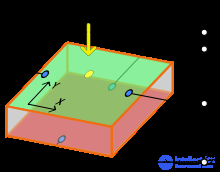
Design of a PSD using a PIN diode
The technical term PSD was first used in a 1957 publication by J.T. Wallmark for lateral photoelectric effect used for local measurements. On a laminar semiconductor, a so-called PIN diode is exposed to a tiny spot of light. This exposure causes a change in local resistance and thus electron flow in four electrodes. From the currents ,
,
and
in the electrodes, the location of the light spot is computed using the following equations.
and
The and
are simple scaling factors, which permit transformation into coordinates.
An advantage of this process is the continuous measurement of the light spot position with measuring rates up to over 100 kHz. The dependence of local measurement on form and size of the light spot as well as the nonlinear connection are a disadvantage that can be partly compensated by special electrode shapes.
2-D tetra-lateral Position Sensitive Device (PSD)[
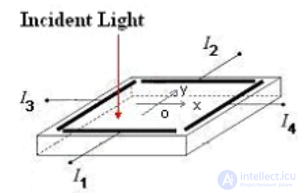
2-D tetra-lateral position sensitive device (PSD)
A 2-D tetra-lateral PSD is capable of providing continuous position measurement of the incident light spot in 2-D. It consists of a single square PIN diode with a resistive layer. When there is an incident light on the active area of the sensor, photocurrents are generated and collected from four electrodes placed along each side of the square near the boundary. The incident light position can be estimated based on currents collected from the electrodes:
and
The 2-D tetra-lateral PSD has the advantages of fast response, much lower dark current, easy bias application and lower fabrication cost. Its measurement accuracy and resolution is independent of the spot shape and size unlike the quadrant detector which could be easily changed by air turbulence. However, it suffers from the nonlinearity problem. While the position estimate is approximately linear with respect to the real position when the spot is in the center area of the PSD, the relationship becomes nonlinear when the light spot is away from the center. This seriously limits its applications and there are urgent demands for linearity improvement in many applications.
To reduce the nonlinearity of 2-D PSD, a new set of formulae have been proposed to estimate the incident light position (Song Cui, Yeng Chai Soh:Linearity indices and linearity improvement of 2-D tetra-lateral position sensitive detector. IEEE Transactions on Electron Devices, Vol. 57, No. 9, pp. 2310-2316, 2010):
and
where :, and
are new scale factors.
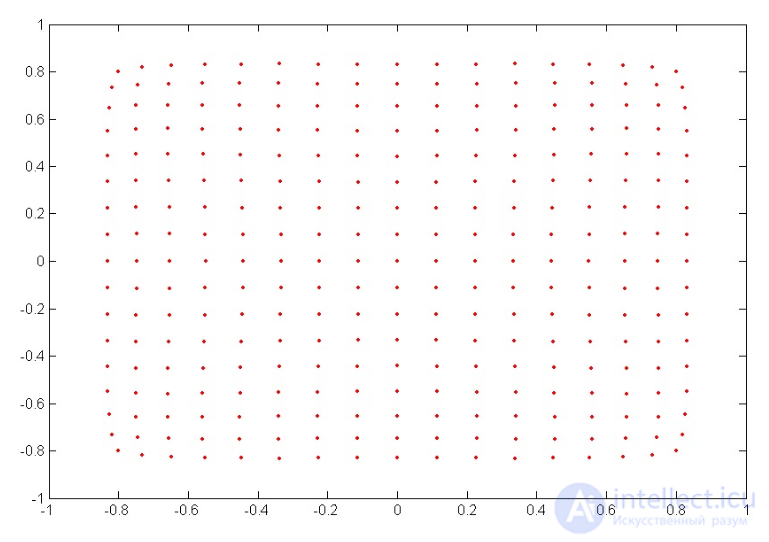
The position response of 2-D tetra-lateral PSD obtained by formulae proposed in S. Cui's paper
The position estimation results obtained by this set of formulae are simulated below. We assume the light spot is moving in steps in both directions and we plot position estimates on a 2-D plane. Thus a regular grid pattern should be obtained if the estimated position is perfectly linear with the true position. The performance is much better than the previous formulae. Detailed simulations and experiment results can be found in S. Cui's paper.
Serial Processing
The most common sensor applications with a sampling rate of less than 1000 Hz are CCD or CMOS cameras. The sensor is partitioned into individual pixels whose exposure value can be read out sequentially. The position of the light spot can be computed with the methods of photogrammetry directly from the brightness distribution.
Parallel Processing

Design of a discrete PSD from Massari with parallel processing. The yellow circle is the illuminated spot.
For faster applications, matrix sensors with parallel processing were developed. Both line by line and in columns, the density of light of each pixel is compared with a global threshold value. The results of comparison become lines and columns with logical OR links. From all columns and all lines the one element that is brighter than a given threshold value is the average value of the coordinates computed of the light spot.
Distinguish track (visual) K. d. ( Wilson chamber , diffusion chamber, discharge-condensation chamber, bubble chamber, spark chamber, streamer chamber, nuclear photographic emulsion); hodoscopic. To. D. containing densely packed small-sized detectors [ionization chambers, Geiger counters, discharge tubes, streamer tubes (drift), scintillation detectors and semiconductor detectors , charge-coupled devices ( CCD detectors ]; ) multi-electrode (multi-wire) K. D. [gas and liquid ionization cameras, proportional cameras, drift cameras(Fig. 1), strip semiconductor detectors]. The coordinates of particle trajectories are determined by their tracks (tracks) in track coordinate detectors or by the numbers of channels (wires) where the signal appears.
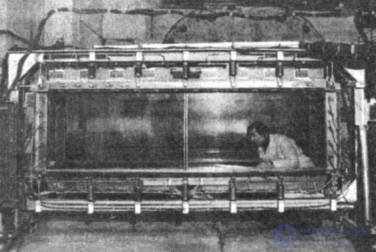
Fig. 1. A package of plane drift chambers (Zm size  0.8 m) with
0.8 m) with  = 0.2 mm.
= 0.2 mm.
C.'s action is based on the local conversion of small portions of energy spent by a particle on the ionization and excitation of atoms of matter into macroscopic. signal carrying information about the place of passage of the particle. This is achieved by means of avalanche-like amplification in a metastable working medium of track K. d. (Supersaturated steam, etc.) or due to an accelerating electric train. field and (or) thanks to ext. electronic device (amplifier, photomultiplier tube , etc.).
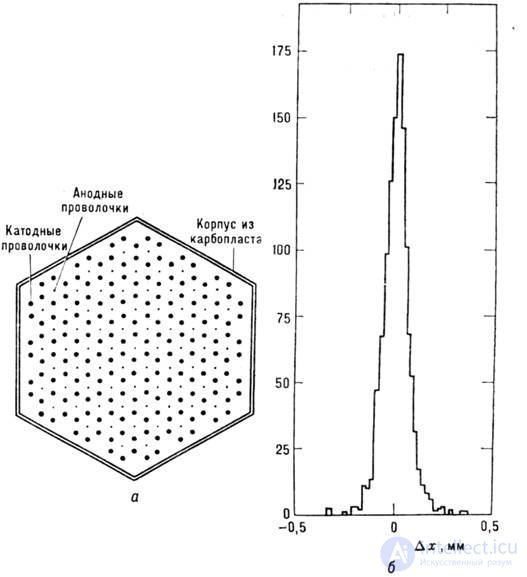
Fig. 2. a - Scheme of a hexagonal proportional chamber (length 0.8 m,  = 45 μm); b - distribution of the results of coordinate measurements.
= 45 μm); b - distribution of the results of coordinate measurements.
Due to the diffusion of electrons and ions formed in the path of the particle, their drift into the electric. field, broadening of ionization bunches during amplification (or of a track in track K. d.), and also due to the discrete structure of K. d. (Fig. 2, a ) the measured coordinate x k - l. the point of the particle’s trajectory differs in value  from its true value. The standard deviation of the values
from its true value. The standard deviation of the values  (Fig. 2, b ) determines the coordinate resolution of the
(Fig. 2, b ) determines the coordinate resolution of the  detector. As a rule,
detector. As a rule,  mm (tab.).
mm (tab.).
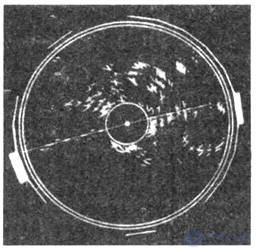
Fig. 3. Two-particle decay of the Z ° boson (on the computer display screen) recorded by the drift camera of the Collider Accelerator-Laboratory E. Fermi (USA).
Coordinate resolution of detectors
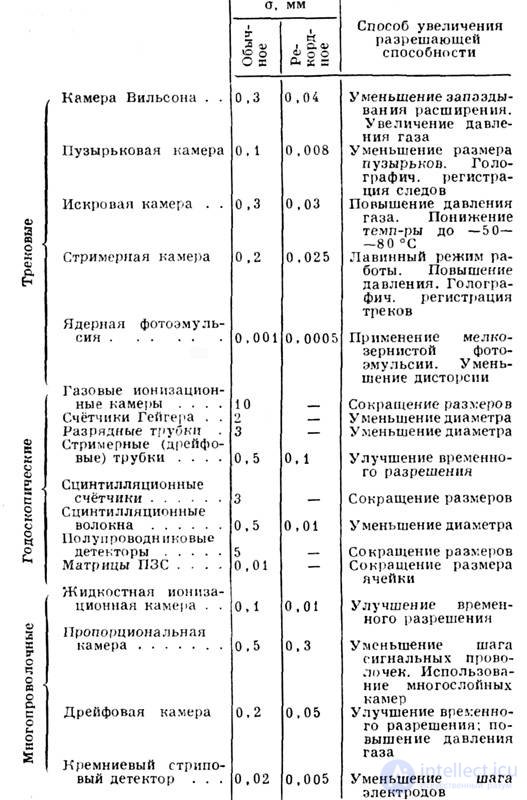
In nuclear emulsion, small bubble chambers with holographic. registration of tracks in high-pressure streamer chambers, strip detectors and CCD matrices  = 0.5-25 microns. Due to such a high resolution, they are used as the so-called. vertex detectors in the study of high-energy particles to obtain detailed information about the processes at the "peak" of the interaction (see Combined detector systems ). By varying the distance between the electrodes, the composition of the substance, the mode (temperature, pressure, electric field strength, and in controlled QDs, the amplitude, duration and delay of the control pulse), the coordinate resolution can be increased. In multiwire quantum wires, this goal is sometimes achieved by determining the coordinates of the "center of gravity" of the distribution of the amplitudes of the signals induced at the signal wires closest to the particle’s passage. A similar method is used in hodoscopic and multiwire shower spectrometers (total absorption spectrometers) to determine the coordinates of a particle forming an electron. or electron-nuclear rain. Here
= 0.5-25 microns. Due to such a high resolution, they are used as the so-called. vertex detectors in the study of high-energy particles to obtain detailed information about the processes at the "peak" of the interaction (see Combined detector systems ). By varying the distance between the electrodes, the composition of the substance, the mode (temperature, pressure, electric field strength, and in controlled QDs, the amplitude, duration and delay of the control pulse), the coordinate resolution can be increased. In multiwire quantum wires, this goal is sometimes achieved by determining the coordinates of the "center of gravity" of the distribution of the amplitudes of the signals induced at the signal wires closest to the particle’s passage. A similar method is used in hodoscopic and multiwire shower spectrometers (total absorption spectrometers) to determine the coordinates of a particle forming an electron. or electron-nuclear rain. Here  =
=  (GeV) mm, where
(GeV) mm, where  is the particle energy (improvement
is the particle energy (improvement  with growth
with growth associated with an increase in the number of spectrometric. channels used to determine the coordinates of the center of gravity of the shower). Since K. in each plane of a hodoscopic or multiwire K. d., As a rule, only one coordinate ( x) is determined , then to measure other coordinates ( y ) adjacent parallel K. planes are rotated 90 ° relative to each other. In cases where a lower accuracy of measurements of the second coordinate is permissible (for example, when measuring a particle’s momentum by the magnetic deviation), it is determined by taking signals from electrodes of other polarity, by dividing the currents on the signal wire, by the signal propagation time along the electrode and etc.
associated with an increase in the number of spectrometric. channels used to determine the coordinates of the center of gravity of the shower). Since K. in each plane of a hodoscopic or multiwire K. d., As a rule, only one coordinate ( x) is determined , then to measure other coordinates ( y ) adjacent parallel K. planes are rotated 90 ° relative to each other. In cases where a lower accuracy of measurements of the second coordinate is permissible (for example, when measuring a particle’s momentum by the magnetic deviation), it is determined by taking signals from electrodes of other polarity, by dividing the currents on the signal wire, by the signal propagation time along the electrode and etc.
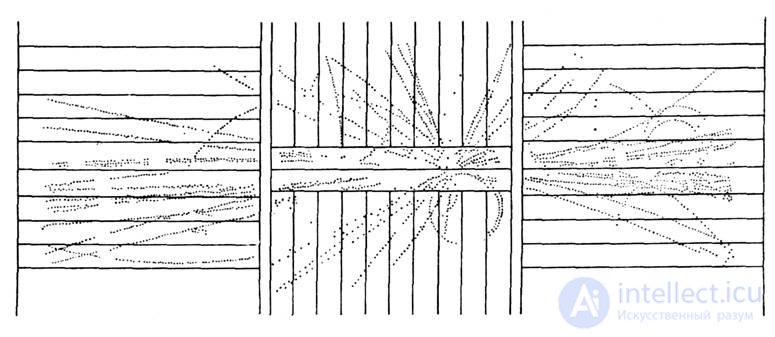
Fig. 4. A multi-particle event recorded by multiwire drift cameras at the accelerator-collider (CERN).
Information from multichannel digital devices is transmitted for processing on a computer and can be visualized on the display screen (Fig. 3). Film information from track K. d. Is processed on viewing automated devices. Filmless methods are also being developed for acquiring track information based on transmitting television tubes or CCD arrays combined with electronic optics. amplifiers. At the same time, the difference between track, hodoscopic, and multiwire wires is erased.
K. d. Are used in experiments on accelerators (Fig. 4), for solving problems of nuclear physics and in the study of cosmic. radiation. The use of quantum dye made it possible to detect certain elementary particles and their decays. K. d. Also used in other studies related to particle registration: in plasma physics, in gamma and neutrino astronomy, in the study of radioactivity. decay, for non-destructive testing and in medicine.
Lit .: Kleinknecht K., Particle detectors, "Phys. Repts", 1982, v. 84, No. 2, p. 86; Sitar B., New Trends in the Development of Drift Chambers, "ECHOAYA", 1987, v. 18, c. 5, p. 1080; Proceedings of the International Symposium on the position-sensitive detectors in high energy physics, Dubna, 22-25 September 1987, Dubna, 1988. G . I. Merzon .
Comments
To leave a comment
Sensors
Terms: Sensors